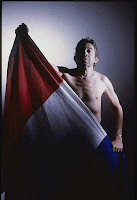I.
'Top of the Pops', by the Rezillos, is one of the great punk singles by one of the great punk bands [1]. And, in August 1978, it led to one of the great punk performances on the BBC show of that name: click here.
But even though the band make it clear in the lyrics to their song that they are critiquing the music industry and the significant role played within it by the broadcast media -
Doesn't matter what is shown
Just as long as everyone knows
What is selling, what to buy
The stock market for your hi-fi [2]
- TOTP producer Robin Nash, simply smiled and said that not
only was it always nice to be mentioned, but that being attacked in this manner demonstrated just how relevant the programme remained even to the punk
generation.
Ultimately, it appears that the cynicism of those who control the media and
the music business trumps the ironic protest of a new wave band.
II.
As if to hammer home this point to those who still believed in the integrity and revolutionary character of their punk idols, we were treated to the spectacle of Legs & Co. dancing to the Sex Pistols on Top of the Pops just eight months later: If you like their pop music, you'll love their pop corn - click here [3].
Perhaps even more surprisingy, the following year Legs and Co. gyrated behind bars to the strains of 'Bankrobber', by The Clash, in a routine squeezed in between songs from Shakin' Stevens [4] and Billy Joel [5].
Worse, the somewhat sentimental punky reggae composition written by Strummer and Jones, which reached number 12 in the UK charts, was sneered at by Cliff Richard, who mockingly declared that it could have been a Eurovision winner: click here [6].
Notes
[1] I'm being generous, of course, but it's hard not to love the Rezillos; an assemblage of art and fashion students from Bonnie Scotland, fronted by Fay Fife, who took a much more fun approach to songwriting than the Clash and described themselves as a new wave beat group rather than a punk rock band. More glam than garage - and seemingly more interested in sci-fi and B-movies than rhythm and blues - the Rezillos are sometimes compared to both the Cramps and the B-52s.
[2] Lyrics from 'Top of the Pops', written by John Callis (or, as he was known whilst a member of the Rezillos, Luke Warm). This track, released in July 1978 as a single from the album Can't Stand the Rezillos (Sire Records, 1978), reached number 17 in the UK chart, whilst the LP did slightly better by getting to number 16 and is now considered something of a classic of the punk-pop genre.
[3] To be fair, 'Silly Thing' is a great pop-punk track by Cook and Jones and the always excellent Legs and Co. - a six-girl dance troupe formed in 1976 - give a spirited and amusing performance, choreographed by Flick Colby.
The line quoted is from the cinema ad sequence in The Great Rock 'n' Roll Swindle (dir. Julien Temple,1980) which correctly predicts the manner in which the Sex Pistols would be co-opted by consumer capitalism and become just another brand name to be stamped on a range of products.
[4] Welsh singer-songwriter Shakin' Stevens released his cover of 'Marie, Marie' as the third single
from his album of the same title (Epic Records, 1980). Despite being released in July, the single did not enter the UK Singles
Chart until the second week of August, staying in the chart for ten
weeks and peaking at number 19 (his first top twenty hit).
[5] The Billy Joel song, 'It's Still Rock 'n' Roll to Me', was released from his hit album Glass Houses (Columbia Records, 1980). It made number 1 in the US, but only reached 14 in the UK. The song conveys Joel's criticisms of the music industry and press for jumping on the new wave bandwagon, when it was merely a rehash, in his view, of older musical forms and inferior to his own brand of slightly more sophisticated, ambitious, and highly polished soft rock.
[6] For those who would prefer to watch the official video for 'Bankrobber' (dir. Don Letts), click here.
To be fair to The Clash, they never did appear in person on Top of the Pops, unlike almost every other punk band at the time (and the reformed Sex Pistols in 1996). However, they did allow the use of videos for 'Should I Stay or Should I Go' and 'Rock the Casbah' on TOTP when these singles were re-released in 1991 (six years after they disbanded).










.jpeg)
